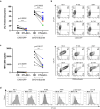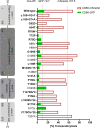Functional Relevance of CTLA4 Variants: an Upgraded Approach to Assess CTLA4-Dependent Transendocytosis by Flow Cytometry
- PMID: 37740092
- PMCID: PMC10661720
- DOI: 10.1007/s10875-023-01582-9
Functional Relevance of CTLA4 Variants: an Upgraded Approach to Assess CTLA4-Dependent Transendocytosis by Flow Cytometry
Erratum in
-
Correction to: Functional Relevance of CTLA4 Variants: an Upgraded Approach to Assess CTLA4‑Dependent Transendocytosis by Flow Cytometry.J Clin Immunol. 2023 Nov;43(8):2090. doi: 10.1007/s10875-023-01596-3. J Clin Immunol. 2023. PMID: 37812314 Free PMC article. No abstract available.
Abstract
Variants of uncertain significance (VUS) in CTLA4 are frequently identified in patients with antibody deficiency or immune dysregulation syndromes including, but not limited to, patients with multi-organ autoimmunity and autoinflammation. However, to ascertain the diagnosis of CTLA4 insufficiency, the functional relevance of each variant needs to be determined. Currently, various assays have been proposed to assess the functionality of CTLA4 VUS, including the analysis of transendocytosis, the biological function of CTLA4 to capture CD80 molecules from antigen presenting cells. Challenges of this assay include weak fluorescence intensity of the internalized ligand, poor reproducibility, and poor performance upon analyzing thawed cells. In addition, the distinction of pathogenic from non-pathogenic variants and from wild-type CTLA4, and the classification of the different VUS according to its level of CTLA4 dysfunction, would be desirable. We developed a novel CD80-expressing cell line for the evaluation of CD80-transendocytosis and compared it to the published transendocytosis assay. Our approach showed lower inter-assay variability and better robustness regardless the type of starting material (fresh or thawed peripheral mononuclear cells). In addition, receiver operating characteristic analysis showed 100% specificity, avoiding false positive results and allowing for a clear distinction between pathogenic and non-pathogenic variants in CTLA4-variant carriers. With our transendocytosis assay, we assessed the pathogenicity of 24 distinct CTLA4 variants from patients submitted to our diagnostic unit. Significantly impaired transendocytosis was demonstrated for 17 CTLA4 variants, whereas seven variants tested normal. In conclusion, our upgraded transendocytosis assay allows a reliable assessment of newly identified variants in CTLA4.
Keywords: CTLA4; LRBA; diagnostics; inborn errors of immunity; transendocytosis.
© 2023. The Author(s).
Conflict of interest statement
The authors declare no competing interests.
Figures






Similar articles
-
What did we learn from CTLA-4 insufficiency on the human immune system?Immunol Rev. 2019 Jan;287(1):33-49. doi: 10.1111/imr.12721. Immunol Rev. 2019. PMID: 30565239 Review.
-
The CTLA-4 immune checkpoint protein regulates PD-L1:PD-1 interaction via transendocytosis of its ligand CD80.EMBO J. 2023 Mar 1;42(5):e111556. doi: 10.15252/embj.2022111556. Epub 2023 Feb 2. EMBO J. 2023. PMID: 36727298 Free PMC article.
-
Characterization of CTLA4 Trafficking and Implications for Its Function.Biophys J. 2018 Oct 2;115(7):1330-1343. doi: 10.1016/j.bpj.2018.08.020. Epub 2018 Aug 23. Biophys J. 2018. PMID: 30219287 Free PMC article.
-
Correction to: Functional Relevance of CTLA4 Variants: an Upgraded Approach to Assess CTLA4‑Dependent Transendocytosis by Flow Cytometry.J Clin Immunol. 2023 Nov;43(8):2090. doi: 10.1007/s10875-023-01596-3. J Clin Immunol. 2023. PMID: 37812314 Free PMC article. No abstract available.
-
CTLA4 gene variants in autoimmunity and cancer: a comparative review.Iran J Immunol. 2011 Sep;8(3):127-49. Iran J Immunol. 2011. PMID: 21931200 Review.
Cited by
-
Mechanistic Insights into the Inhibition of a Common CTLA-4 Gene Mutation in the Cytoplasmic Domain.Molecules. 2024 Mar 16;29(6):1330. doi: 10.3390/molecules29061330. Molecules. 2024. PMID: 38542966 Free PMC article.
References
Publication types
MeSH terms
Substances
LinkOut - more resources
Full Text Sources

